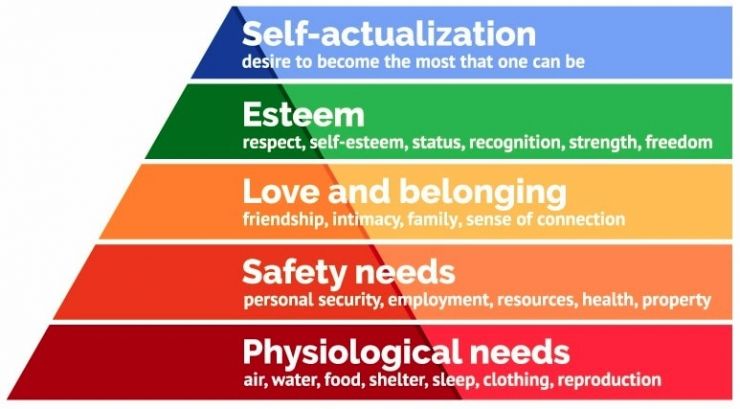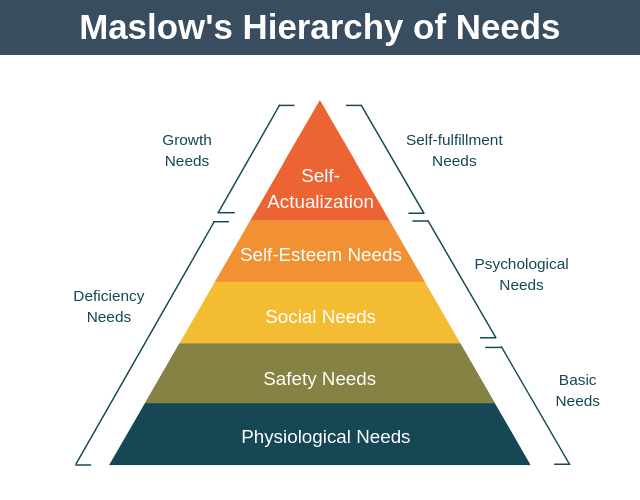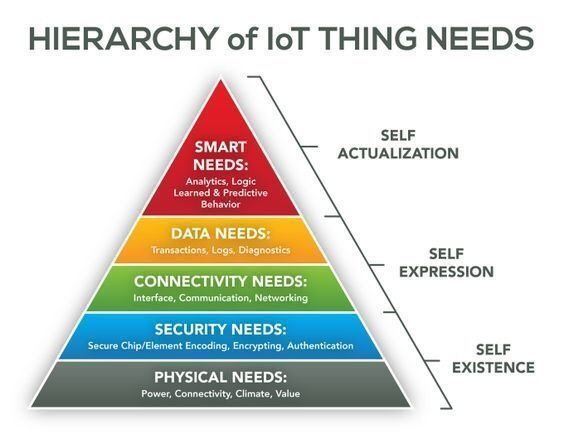
How can a workplace build a company culture that is sensitive to its workers?
How do we maintain dignity and respect for one another during trying times?
How should we direct our focus when we want to take care of one another, not take it out on each other?
We bring it back to the hierarchy of needs. If you’re not familiar, sit back, relax, and let your resident social worker guide you through the process!
Abraham Maslow was a twentieth century humanistic psychologist, a believer that all people hold an innate goodness, value, and worth that makes them deserving of having their needs met.
His concept of the Hierarchy of Needs comes from the perspective that there are basic, core needs that all humans require; the order in which they can be obtained requires a strong foundation at the base before additional needs can become a focus to be met.
Many believe that the Hierarchy of Needs can be used to transform workplace culture and should be the bedrock of any corporate wellness strategy.
So what does this mean, if you’re working to promote these changes in your team, or even for yourself?
The pyramid, broken down into five categories , functions as a bottom-up process.

1. Start with caring about the Physiological Needs of your teammates and yourself. Promote flexibility around bathroom, meal and snack, and general rest breaks. Did you know that ideally, we should spend 10 minutes away from our computer screens every hour? Many scoff at the idea of losing that amount of productive screen time each workday, but consider how you might accomplish more in that 50-minute period each hour that you’re working when you’re giving yourself some peace of mind regularly. Likewise, clear and consistent boundaries around workers taking downtime will allow them to take care of these physiological needs without additional stress around time off. Avoid punitive measures that make anyone feel like a worker first and a person second.
2. Allow your staff to address their Safety Needs by providing ample freedom for appointments related to medical, mental health, dental, and vision care, as well as adequate medical and retirement benefits. Similarly, providing space to take care of emergencies that arise, like a broken pipe or a hospitalized child, will go a long way to promote safety in your company’s culture. Make sure that you do everything you can to keep your workplace safe from threat of injury or violence, including verbal bullying and non-verbal intimidation.
3. Let the needs for Love and Belonging express in two ways: inter-office camaraderie and family-friendly company policies. While nobody really enjoys mandated fun, there are ways to organically work with your team’s shared interests and passions to elicit joyful activities. Take 10-15 minutes on Monday morning to find out if anyone would like to share about their Halloween and ask if anyone has streamed a show they recommend lately. Common ground is everywhere and genuine connection forms when we connect on what we love. If you value the multitude of your worker, including their interests and interpersonal connections outside the workplace, then it will resonate within your company culture. An important factor is instituting paid parental leave programs, flexibility in scheduling, on-site pumping rooms when applicable, and through offering aid in child-care costs.
4. Once you are confident you have tackled Physiological, Safety, and Love and Belonging, it’s time to focus on Esteem Needs. At this level, we’ve established a foundation upon which courage and creativity can flourish. When we have what we need to establish a sense of security and belonging, our mind moves beyond survival instincts into a zone of expansion. Even if we sometimes have sparks of inspiration during a moment of panic, we tend to do our best in terms of motivation and productivity when we have our needs met. As tasks are accomplished and validated, our esteem grows; we feel better about ourselves and those providing recognition. A cycle forms, of intrinsic and extrinsic respect between workers, driving further interactions. Can you imagine what happens when this cycle takes on more negative, discouraging undertones? Often, that is the cycle we are looking to break when we focus on improving company culture.
5. The peak! When all levels leading up to it are satisfied, Self-actualization comes naturally. When you notice your team members going above and beyond, looking outside of their role, crafting novel experiences for themselves, the team, and your clients, that is when you know you have cultivated a company culture that fosters self-actualization. This step will never be reached by a leadership that dictates each member stays within their job description and crushes innovation. Workers enjoy autonomy and accountability at this level; what needs to be done is accomplished and there is room to step outside the ordinary into the extraordinary. When you allow your team members to be extraordinary, they will help you grow your business beyond your wildest dreams. Why? They’re offering their dreams to you as well.
A cycle of empowerment, where leadership looks a little flatter, because you have all risen up the hierarchy together.
Many areas of life can be categorized into a hierarchy of needs! Check out the inspiration for this post, from a recent retweet on Twitter:

